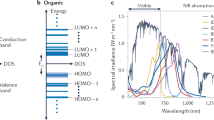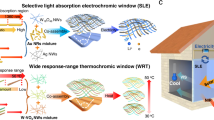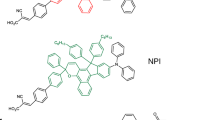Abstract
Current smart window technologies offer dynamic control of the optical transmission of the visible and near-infrared portions of the solar spectrum to reduce lighting, heating and cooling needs in buildings and to improve occupant comfort. Solar cells harvesting near-ultraviolet photons could satisfy the unmet need of powering such smart windows over the same spatial footprint without competing for visible or infrared photons, and without the same aesthetic and design constraints. Here, we report organic single-junction solar cells that selectively harvest near-ultraviolet photons, produce open-circuit voltages eclipsing 1.6 V and exhibit scalability in power generation, with active layers (10 cm2) substantially larger than those typical of demonstration organic solar cells (0.04–0.2 cm2). Integration of these solar cells with a low-cost, polymer-based electrochromic window enables intelligent management of the solar spectrum, with near-ultraviolet photons powering the regulation of visible and near-infrared photons for natural lighting and heating purposes.
This is a preview of subscription content, access via your institution
Access options
Access Nature and 54 other Nature Portfolio journals
Get Nature+, our best-value online-access subscription
$29.99 / 30 days
cancel any time
Subscribe to this journal
Receive 12 digital issues and online access to articles
$119.00 per year
only $9.92 per issue
Buy this article
- Purchase on Springer Link
- Instant access to full article PDF
Prices may be subject to local taxes which are calculated during checkout








Similar content being viewed by others
Change history
18 September 2017
In the version of this Article originally published, Fig. 4f was incorrect. This error has now been corrected.
References
Korgel, B. A. Materials science: composite for smarter windows. Nature 500, 278–279 (2013).
Dyer, A. L. et al. A vertically integrated solar-powered electrochromic window for energy efficient buildings. Adv. Mater. 26, 4895–4900 (2014).
US Dep. Energy, Energy Efficiency and Renewable Energy 2011 Buildings Energy Data Book (D & R International, Ltd., 2012); http://go.nature.com/2rI7grb
Wang, Y., Runnerstom, E. L. & Milliron, D. J. Switchable materials for smart windows. Annu. Rev. Chem. Biomol. Eng. 7, 283–304 (2016).
Shehabi, A. et al. U.S. energy savings potential from dynamic daylighting control glazings. Energy Build. 66, 415–423 (2013).
DeForest, N. et al. United States energy and CO2 savings potential from deployment of near-infrared electrochromic window glazings. Build. Environ. 89, 107–117 (2015).
Llordés, A., Garcia, G., Gazquez, J. & Milliron, D. J. Tunable near-infrared and visible-light transmittance in nanocrystal-in-glass composites. Nature 500, 323–326 (2013).
Khandelwal, H., Schenning, A. P. H. J. & Debije, M. G. Infrared regulating smart window based on organic materials. Adv. Energy Mater. 1602209 http://dx.doi.org/10.1002/aenm.201602209 (2017).
Wu, J.-J. et al. Fast-switching photovoltachromic cells with tunable transmittance. ACS Nano 3, 2297–2303 (2009).
Cannavale, A. et al. Perovskite photovoltachromic cells for building integration. Energy Environ. Sci. 8, 1578–1584 (2015).
Cannavale, A. et al. Forthcoming perspectives of photoelectrochromic devices: a critical review. Energy Environ. Sci. 9, 2682–2719 (2016).
Lunt, R. R. & Bulovic, V. Transparent, near-infrared organic photovoltaic solar cells for window and energy-scavenging applications. Appl. Phys. Lett. 98, 113305 (2011).
Betancur, R. et al. Transparent polymer solar cells employing a layered light-trapping architecture. Nat. Photon. 7, 995–1000 (2013).
Chen, C. et al. Visibly transparent polymer solar cells produced by solution processing. ACS Nano 6, 7185–7190 (2012).
Polman, A. et al. Photovoltaic materials: present effiencies and future challenges. Science 352, aad4424 (2016).
Gao, Y. et al. Homo-tandem polymer solar cells with Voc > 1.8 V for efficient PV-driven water splitting. Adv. Mater. 28, 3366–3373 (2016).
Zhang, X. et al. Flexible all-solution-processed all-plastic multijunction solar cells for powering electronic devices. Mater. Horiz. 3, 452–459 (2016).
Heliatek Heliatek Sets New Organic Photovoltaic World Record Efficiency of 13.2% (2016); http://www.heliatek.com/en/press/press-releases/details/heliatek-sets-new-organic-photovoltaic-world-record-efficiency-of-13-2
Rand, B. P., Burk, D. P. & Forrest, S. R. Offset energies at organic semiconductor heterojunctions and their influence on the open-circuit voltage of thin-film solar cells. Phys. Rev. B 75, 115327 (2007).
Davy, N. C. et al. Contorted hexabenzocoronenes with extended heterocyclic moieties improve visible-light absorption and performance in organic solar cells. Chem. Mater. 28, 673–681 (2016).
Hiszpanski, A. M. et al. Halogenation of a nonplanar molecular semiconductor to tune energy levels and bandgaps for electron transport. Chem. Mater. 27, 1892–1900 (2015).
Loo, Y.-L. et al. Unusual molecular conformations in fluorinated, contorted hexabenzocoronenes. Org. Lett. 12, 4840–4843 (2010).
Hiszpanski, A. M. et al. Post-deposition processing methods to induce preferential orientation in contorted hexabenzocoronene thin films. ACS Nano 7, 294–300 (2013).
Hiszpanski, A. M. et al. Tuning polymorphism and orientation in organic semiconductor thin films via post-deposition processing. J. Am. Chem. Soc. 136, 15749–15756 (2014).
Benning, P. J. et al. C60 and C70 fullerenes and potassium fullerides. Phys. Rev. B 45, 6899–6913 (1992).
Sullivan, P. et al. An N-ethylated barbituric acid end-capped bithiophene as an electron-acceptor material in fullerene-free organic photovoltaics. Chem. Commun. 51, 6222–6225 (2015).
Akkerman, Q. A. et al. Strongly emissive perovskite nanocrystal inks for high-voltage solar cells. Nat. Energy 2, 16194 (2016).
Peng, Y. et al. High open-circuit voltage, high fill factor single-junction organic solar cells. Appl. Phys. Lett. 105, 083304 (2014).
Sullivan, P. et al. Halogenated boron subphthalocyanines as light harvesting electron acceptors in organic photovoltaics. Adv. Energy Mater. 1, 352–355 (2011).
Bartynski, A. N. et al. Symmetry-breaking charge transfer in a zinc chlorodipyrrin acceptor for high open circuit voltage organic photovoltaics. J. Am. Chem. Soc. 137, 5397–5405 (2015).
Bijleveld, J. C., Verstrijden, R. A. M., Wienk, M. M. & Janssen, R. A. J. Maximizing the open-circuit voltage of polymer: fullerene solar cells. Appl. Phys. Lett. 97, 85–88 (2010).
Suddard-Bangsund, J. et al. Organic salts as a route to energy level control in low bandgap, high open-circuit voltage organic and transparent solar cells that approach the excitonic voltage limit. Adv. Energy Mater. 6, 1501659 (2015).
Masuko, K. et al. Achievement of more than 25% conversion heterojunction solar cell. IEEE J. Photovolt. 4, 1433–1435 (2014).
Ben Dkhil, S. et al. Square-centimeter-sized high-efficiency polymer solar cells: how the processing atmosphere and film quality influence performance at large scale. Adv. Energy Mater. 6, 1600290 (2016).
Choi, S., Potscavage, W. J. & Kippelen, B. Area-scaling of organic solar cells. J. Appl. Phys. 106, 54507 (2009).
Verreet, B., Heremans, P., Stesmans, A. & Rand, B. P. Microcrystalline organic thin-film solar cells. Adv. Mater. 25, 5504–5507 (2013).
Cnops, K. et al. 8.4% efficient fullerene-free organic solar cells exploiting long-range exciton energy transfer. Nat. Commun. 5, 3406 (2014).
Li, Y. et al. High-efficiency robust perovskite solar cells on ultrathin flexible substrates. Nat. Commun. 7, 10214 (2016).
Zhan, C., Zhang, X. & Yao, J. New advances in non-fullerene acceptor based organic solar cells. RSC Adv. 5, 93002–93026 (2015).
Tsai, P. et al. Large-area organic solar cells by accelerated blade coating. Org. Electron. 22, 166–172 (2015).
Agrawal, N. et al. Efficient up-scaling of organic solar cells. Sol. Energy Mater. Sol. Cells 157, 960–965 (2016).
Organic Solar Cells: Fundamentals, Devices, and Upscaling (Pan Stanford Publishing Pte. Ltd., 2014).
Peters, C. H. et al. High Efficiency Polymer solar cells with long operating lifetimes. Adv. Energy Mater. 1, 491–494 (2011).
Peters, C. H. et al. The mechanism of burn-in loss in a high efficiency polymer solar cell. Adv. Mater. 24, 663–668 (2012).
Zhang, Y. et al. PCDTBT based solar cells: one year of operation under real-world conditions. Sci. Rep. 6, 21632 (2016).
Tong, X. et al. Intrinsic burn-in efficiency loss of small-molecule organic photovoltaic cells due to exciton-induced trap formation. Sol. Energy Mater. Sol. Cells 118, 116–123 (2013).
Cheng, P. & Zhan, X. Stability of organic solar cells: challenges and strategies. Chem. Soc. Rev. 45, 2544–2582 (2016).
Xie, Z. et al. Integrated smart electrochromic windows for energy saving and storage applications. Chem. Commun. 50, 608–610 (2014).
Amasawa, E., Sasagawa, N., Kimura, M. & Taya, M. Design of a new energy-harvesting electrochromic window based on an organic polymeric dye, a cobalt couple, and PProDOT-Me2 . Adv. Energy Mater. 4, 1400379 (2014).
Tarver, J. D., Yoo, J. E. & Loo, Y.-L. Polyaniline exhibiting stable and reversible switching in the visible extending into the near-IR in aqueous media. Chem. Mater. 22, 2333–2340 (2010).
Yoo, J. E. et al. Directly patternable, highly conducting polymers for broad applications in organic electronics. Proc. Natl Acad. Sci. USA 107, 5712–5717 (2010).
Yoo, J. E. et al. Polymer conductivity through particle connectivity. Chem. Mater. 21, 1948–1954 (2009).
Yoo, J. E., Bucholz, T. L., Jung, S. & Loo, Y.-L. Narrowing the size distribution of the polymer acid improves PANI conductivity. J. Mater. Chem. 18, 3129–3135 (2008).
Yoo, J. E. et al. Improving the electrical conductivity of polymer acid-doped polyaniline by controlling the template molecular weight. J. Mater. Chem. 17, 1268–1275 (2007).
Horowitz, A. I., Wang, Y. & Panzer, M. J. Reclamation and reuse of ionic liquids from silica-based ionogels using spontaneous water-driven separation. Green Chem. 15, 3414–3420 (2013).
Lin, T. H. & Ho, K. C. A. complementary electrochromic device based on polyaniline and poly(3,4-ethylenedioxythiophene). Sol. Energy Mater. Sol. Cells 90, 506–520 (2006).
Tarver, J. & Loo, Y.-L. Mesostructures of polyaniline films affect polyelectrochromic Switching. Chem. Mater. 23, 4402–4409 (2011).
Hachmann, J. et al. The Harvard clean energy project: large-scale computational screening and design of organic photovoltaics on the world community grid. J. Phys. Chem. Lett. 2, 2241–2251 (2011).
Arroyave, F. A. & Reynolds, J. R. Dioxypyrrole-based polymers via dehalogenation polycondensation using various electrophilic halogen sources. Macromolecules 45, 5842–5849 (2012).
Wu, C. I., Hirose, Y., Sirringhaus, H. & Kahn, A. Electron-hole interaction energy in the organic molecular semiconductor PTCDA. Chem. Phys. Lett. 272, 43–47 (1997).
Hanson, E. L. et al. Bonding self-assembled, compact organophosphonate monolayers to the native oxide surface of silicon. J. Am. Chem. Soc. 125, 16074–16080 (2003).
Acknowledgements
N.C.D. acknowledges financial support from the National Science Foundation Graduate Research Fellowship Program under Grant No. DGE 1148900. We (N.C.D., M.S.-E. and Y.-L.L.) acknowledge support from NSF MRSEC funding through Princeton Center for Complex Materials (DMR-1420541) and the Wilke Family Fund administered by the School of Engineering and Applied Science at Princeton University. A.K. acknowledges support from the National Science Foundation under Grant No. DMR-1506097. We thank M. Panzer and H. Qin of Tufts University for valuable discussions regarding ionogels, and G. Man of Princeton University for assistance with UPS/IPES analysis.
Author information
Authors and Affiliations
Contributions
N.C.D., M.S.-E. and Y.-L.L. wrote the manuscript; N.C.D. synthesized molecular semiconductors; X.L. and A.K. provided UPS/IPES measurements and analysis; N.C.D. and J.G. fabricated and characterized PV cells; M.S.-E. synthesized PANI-PAAMPSA; M.S.-E. and A.L. fabricated and characterized ECWs; M.S.-E. and N.D. integrated ECW and PV components for solar-powered ECW demonstration. N.Y. conducted TEM sample preparation and imaging. All authors discussed the results and reviewed the manuscript.
Corresponding author
Ethics declarations
Competing interests
The authors declare no competing financial interests.
Supplementary information
Supplementary Information
Supplementary Figures 1–10 and Supplementary Tables 1 and 2. (PDF 985 kb)
Supplementary Video 1
Demonstration of a 2.25 cm2 solar-powered electrochromic window comprising stacked films of PANI-PAAPMSA and PEDOT:PSS separated by a gel electrolyte. The switching of this window between its coloured and bleached states is driven by a 1.38 cm2 D/A1 cell under 1 sun AM1.5G illumination. (MP4 19631 kb)
Rights and permissions
About this article
Cite this article
Davy, N., Sezen-Edmonds, M., Gao, J. et al. Pairing of near-ultraviolet solar cells with electrochromic windows for smart management of the solar spectrum. Nat Energy 2, 17104 (2017). https://doi.org/10.1038/nenergy.2017.104
Received:
Accepted:
Published:
DOI: https://doi.org/10.1038/nenergy.2017.104
This article is cited by
-
Recent progress in Prussian blue electrode for electrochromic devices
Frontiers in Energy (2024)
-
Electrochromic windows based on luminescent acrylate/ionosilicas
Journal of Sol-Gel Science and Technology (2024)
-
Improving morphology and optoelectronic properties of ultra-wide bandgap perovskite via Cs tuning for clear solar cell and UV detection applications
Scientific Reports (2023)
-
Highly transparent silanized cellulose aerogels for boosting energy efficiency of glazing in buildings
Nature Energy (2023)
-
Hydroxycinnamic acid derivatives for UV-selective and visibly transparent dye-sensitized solar cells
Scientific Reports (2023)



